Seven years ago, I tumbled down the rabbit hole of software reverse engineering for a few months. Armed only with a middling grasp of C, every step felt like navigating a maze blindfolded. Yet, through sheer stubbornness, I somehow conquered my first beginner-level Capture The Flag (CTF) challenge. It was called "EzReverse", from the EasyCTF IV competition. And that tiny victory still makes me proud!
Today, I’m resurrecting that ancient writeup for posterity. Treat it as a time capsule from my short-lived hacker phase. It has been slightly polished for clarity, but otherwise mostly unchanged, apart from an added conclusion. If it makes even one person’s curious enough to disassemble a binary and peek inside, mission accomplished.
A disclaimer though: The techniques are all self-taught, and the tools used are possibly outdated. The following are the thoughts of a curious amateur, not an expert.
Introduction
This is my first real challenge, and as such, it took me around 20h to solve. Instead of showing the best way to find the flag, I'll explain my thought process and show my mistakes, so that you, the reader, can learn from both. Since this is an easy challenge, this write-up is primarily targeted to newbies like me, although I'm sure a more experienced reverse engineers can get a laugh or two at my mistakes :).
What you'll need to follow along :
- Some basic programming knowledge (an introductory course to C or/and Python should be enough)
- A basic understanding of Linux's CLI (ls, cd, echo... )
- A basic understanding of how hexadecimal works (If you are able to count to 0xff, you are good)
- A basic understanding of how ASCII works (and an ASCII table)
- A linux Virtual Machine
Depending on your skill on each topic, a good day to a good week of googling should give you everything you need to tag along! Also, if you are new to this or simply a bit rusty, I can't recommend enough this youtube playlist by LiveOverflow. Watch it to at least the 8th video, practice a little bit with the examples he gives and you'll have no problem understanding this write-up.
I started with a brand new Fedora 27 Virtual Machine, and not much else. I downloaded the binary from CTFTime, noticed that a write-up already existed, promised myself to not read it and started right away.
Chmod: the permission I forgot
I thought I would first run the executable to see what it does. And I ran into the first problem : it wouldn't start.
$ ./executable bash: ./executable: Permission denied
So, after looking for solutions online, I ran the file command, which will say what linux thinks this file is:
$ file executable executable: ELF 64-bit LSB executable, x86-64, version 1 (SYSV), dynamically linked, interpreter /lib64/ld-linux-x86-64.so.2, for GNU/Linux 2.6.32, BuildID[sha1]=eb7a47c52c657a17b5ae730826c4640de86b0dcf, not stripped
Mmmmh. My modest knowledge tells me that this should have worked... Fair enough. Instead let's hexdump it to see what it contains! hexdump is printing the actual zeros and ones that make the file, but converted in an hexadecimal format. Some numbers correspond to letters. The -C parameter shows those letters on the right.
$ hexdump -C executable 00000000 7f 45 4c 46 02 01 01 00 00 00 00 00 00 00 00 00 |.ELF............| 00000010 02 00 3e 00 01 00 00 00 b0 06 40 00 00 00 00 00 |..>.......@.....| 00000020 40 00 00 00 00 00 00 00 60 1b 00 00 00 00 00 00 |@.......`.......| 00000030 00 00 00 00 40 00 38 00 09 00 40 00 1e 00 1b 00 |....@.8...@.....| 00000040 06 00 00 00 05 00 00 00 40 00 00 00 00 00 00 00 |........@.......| 00000050 40 00 40 00 00 00 00 00 40 00 40 00 00 00 00 00 |@.@.....@.@.....| 00000060 f8 01 00 00 00 00 00 00 f8 01 00 00 00 00 00 00 |................| 00000070 08 00 00 00 00 00 00 00 03 00 00 00 04 00 00 00 |................| 00000080 38 02 00 00 00 00 00 00 38 02 40 00 00 00 00 00 |8.......8.@.....| 00000090 38 02 40 00 00 00 00 00 1c 00 00 00 00 00 00 00 |8.@.............| 000000a0 1c 00 00 00 00 00 00 00 01 00 00 00 00 00 00 00 |................| 000000b0 01 00 00 00 05 00 00 00 00 00 00 00 00 00 00 00 |................| 000000c0 00 00 40 00 00 00 00 00 00 00 40 00 00 00 00 00 |..@.......@.....| 000000d0 0c 0c 00 00 00 00 00 00 0c 0c 00 00 00 00 00 00 |................| 000000e0 00 00 20 00 00 00 00 00 01 00 00 00 06 00 00 00 |.. .............| 000000f0 e0 0d 00 00 00 00 00 00 e0 0d 60 00 00 00 00 00 |..........`.....| 00000100 e0 0d 60 00 00 00 00 00 7c 02 00 00 00 00 00 00 |..`.....|.......| 00000110 98 02 00 00 00 00 00 00 00 00 20 00 00 00 00 00 |.......... .....| 00000120 02 00 00 00 06 00 00 00 f8 0d 00 00 00 00 00 00 |................| 00000130 f8 0d 60 00 00 00 00 00 f8 0d 60 00 00 00 00 00 |..`.......`.....| 00000140 00 02 00 00 00 00 00 00 00 02 00 00 00 00 00 00 |................| 00000150 08 00 00 00 00 00 00 00 04 00 00 00 04 00 00 00 |................| 00000160 54 02 00 00 00 00 00 00 54 02 40 00 00 00 00 00 |T.......T.@.....| 00000170 54 02 40 00 00 00 00 00 44 00 00 00 00 00 00 00 |T.@.....D.......| 00000180 44 00 00 00 00 00 00 00 04 00 00 00 00 00 00 00 |D...............| 00000190 50 e5 74 64 04 00 00 00 94 0a 00 00 00 00 00 00 |P.td............| 000001a0 94 0a 40 00 00 00 00 00 94 0a 40 00 00 00 00 00 |..@.......@.....| 000001b0 44 00 00 00 00 00 00 00 44 00 00 00 00 00 00 00 |D.......D.......| 000001c0 04 00 00 00 00 00 00 00 51 e5 74 64 06 00 00 00 |........Q.td....| 000001d0 00 00 00 00 00 00 00 00 00 00 00 00 00 00 00 00 |................| * 000001f0 00 00 00 00 00 00 00 00 10 00 00 00 00 00 00 00 |................| 00000200 52 e5 74 64 04 00 00 00 e0 0d 00 00 00 00 00 00 |R.td............| 00000210 e0 0d 60 00 00 00 00 00 e0 0d 60 00 00 00 00 00 |..`.......`.....| 00000220 20 02 00 00 00 00 00 00 20 02 00 00 00 00 00 00 | ....... .......| 00000230 01 00 00 00 00 00 00 00 2f 6c 69 62 36 34 2f 6c |......../lib64/l| 00000240 64 2d 6c 69 6e 75 78 2d 78 38 36 2d 36 34 2e 73 |d-linux-x86-64.s| 00000250 6f 2e 32 00 04 00 00 00 10 00 00 00 01 00 00 00 |o.2.............| [...] 000021b0 60 10 60 00 00 00 00 00 5c 10 00 00 00 00 00 00 |`.`.....\.......| 000021c0 18 00 00 00 00 00 00 00 00 00 00 00 00 00 00 00 |................| 000021d0 10 00 00 00 00 00 00 00 00 00 00 00 00 00 00 00 |................| 000021e0 ff 00 00 00 01 00 00 00 30 00 00 00 00 00 00 00 |........0.......| 000021f0 00 00 00 00 00 00 00 00 5c 10 00 00 00 00 00 00 |........\.......| 00002200 2d 00 00 00 00 00 00 00 00 00 00 00 00 00 00 00 |-...............| 00002210 01 00 00 00 00 00 00 00 01 00 00 00 00 00 00 00 |................| 00002220 11 00 00 00 03 00 00 00 00 00 00 00 00 00 00 00 |................| 00002230 00 00 00 00 00 00 00 00 89 10 00 00 00 00 00 00 |................| 00002240 08 01 00 00 00 00 00 00 00 00 00 00 00 00 00 00 |................| 00002250 01 00 00 00 00 00 00 00 00 00 00 00 00 00 00 00 |................| 00002260 01 00 00 00 02 00 00 00 00 00 00 00 00 00 00 00 |................| 00002270 00 00 00 00 00 00 00 00 98 11 00 00 00 00 00 00 |................| 00002280 f0 06 00 00 00 00 00 00 1d 00 00 00 2d 00 00 00 |............-...| 00002290 08 00 00 00 00 00 00 00 18 00 00 00 00 00 00 00 |................| 000022a0 09 00 00 00 03 00 00 00 00 00 00 00 00 00 00 00 |................| 000022b0 00 00 00 00 00 00 00 00 88 18 00 00 00 00 00 00 |................| 000022c0 d8 02 00 00 00 00 00 00 00 00 00 00 00 00 00 00 |................| 000022d0 01 00 00 00 00 00 00 00 00 00 00 00 00 00 00 00 |................| 000022e0
I may have overestimated myself a bit here, I have no idea what this all means. Still, I see ELF and ld-linux-x86-64.so.2, which probably means that this file is a Linux executable. So why doesn't it work? After a while, I wondered if it is possible that, since it's an easy challenge, the flag had been included in the binary, which was itself corrupted so no one could actually run it. The strings command goes through the whole file and only outputs what it thinks a human could read. Let's try it!
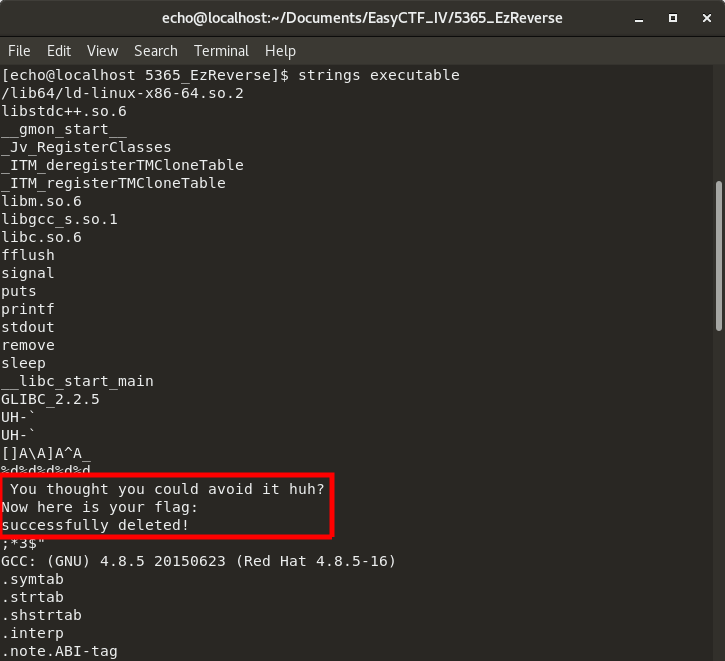
That's progress! Some interesting strings (even though it's no flag!), especially some function and other names I recognize from my C days :
puts()printf()stdout()- gcc...
So this program must be written in C (or maybe C++, I saw a libstdc++ string too). I gotta say the "You thought you could avoid it huh?" has me a little scared... Now, if I could just run it, that would be great. And then it struck me : on linux, you need to give a file execution permissions before running it. That is done with the chmod +x nameOfTheFile command. I am way too ashamed to tell you how long it took me to find/remember this...
Now, let's try to run it.
$ chmod +x ./executable $ ./executable $
That was anticlimactic. Let's try to run it with an argument then:
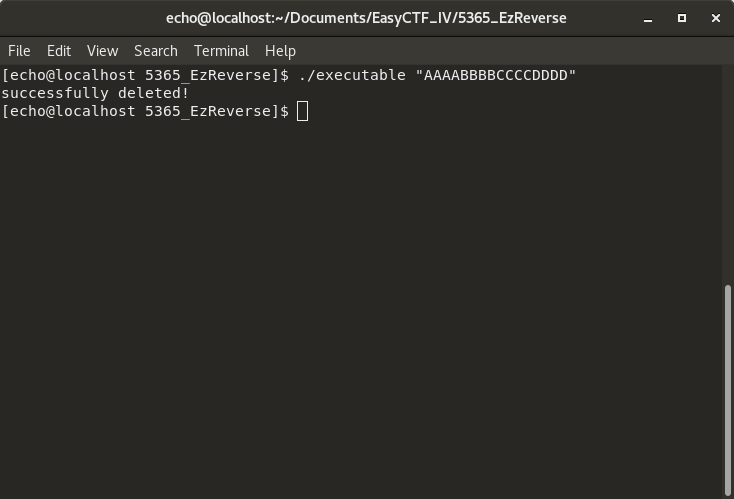
That... is not a good sign... what was deleted? let's try to run it again:
$ ./executable bash: ./executable: No such file or directory $ ls $
This stupid program deleted itself ! Well, I guess I'll download it again. Also, I didn't try it at first, but later I found out that even if you press CTRL + C while it's deleting itself, you get the ""You thought you could avoid it huh?" string, and the program still deletes itself.
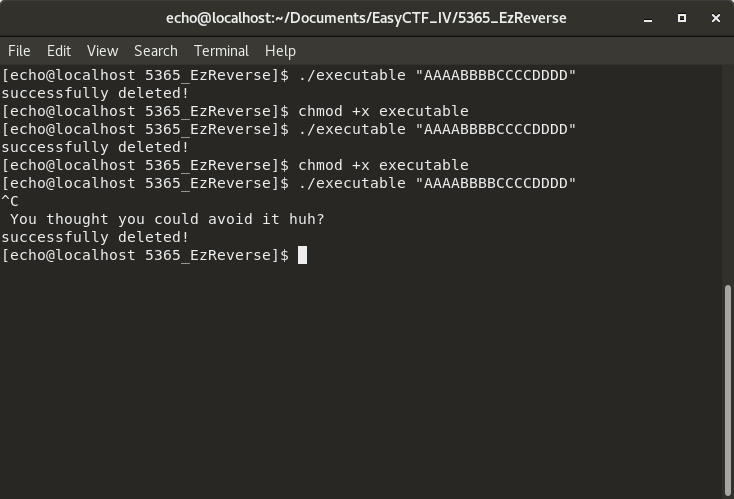
Still, it's an interesting behavior. It means that I cannot try a so called "bruteforce" attack, or I'll need to re-download the binary after every failed attempt. I'll have to disassemble it and understand what it does to give it the argument it expects right away. I guess I'll take the challenge's hint :
Objdump the executable and read some assembly
What does this mess do?
Disassembling a program means finding the instructions the processor follows. It is usually written in a very low level language: assembly (asm). Objdump is a program that can do this disassembly for us, and show us the asm code of the binary. Since it's been hinted at, let's try it! (I'll only show the disassembly of the main function here, but the output is much longer)
$ objdump -d executable executable: file format elf64-x86-64 [...] 0000000000400835 <main>: 400835: 55 push %rbp 400836: 48 89 e5 mov %rsp,%rbp 400839: 48 83 ec 30 sub $0x30,%rsp 40083d: 89 7d dc mov %edi,-0x24(%rbp) 400840: 48 89 75 d0 mov %rsi,-0x30(%rbp) 400844: be f1 07 40 00 mov $0x4007f1,%esi 400849: bf 02 00 00 00 mov $0x2,%edi 40084e: e8 2d fe ff ff callq 400680 <signal@plt> 400853: 48 8b 45 d0 mov -0x30(%rbp),%rax 400857: 48 8b 00 mov (%rax),%rax 40085a: 48 89 05 0f 08 20 00 mov %rax,0x20080f(%rip) # 601070 <target> 400861: 8b 45 dc mov -0x24(%rbp),%eax 400864: 83 f8 02 cmp $0x2,%eax 400867: 74 0b je 400874 <main+0x3f> 400869: 90 nop 40086a: b8 02 00 00 00 mov $0x2,%eax 40086f: e9 1c 01 00 00 jmpq 400990 <main+0x15b> 400874: 90 nop 400875: 48 8b 45 d0 mov -0x30(%rbp),%rax 400879: 48 8b 40 08 mov 0x8(%rax),%rax 40087d: 48 89 45 f8 mov %rax,-0x8(%rbp) 400881: c7 45 e0 01 00 00 00 movl $0x1,-0x20(%rbp) 400888: c7 45 e4 02 00 00 00 movl $0x2,-0x1c(%rbp) 40088f: c7 45 e8 03 00 00 00 movl $0x3,-0x18(%rbp) 400896: c7 45 ec 04 00 00 00 movl $0x4,-0x14(%rbp) 40089d: c7 45 f0 05 00 00 00 movl $0x5,-0x10(%rbp) 4008a4: 8b 55 e0 mov -0x20(%rbp),%edx 4008a7: 48 8b 45 f8 mov -0x8(%rbp),%rax 4008ab: 0f b6 00 movzbl (%rax),%eax 4008ae: 0f be c0 movsbl %al,%eax 4008b1: 01 d0 add %edx,%eax 4008b3: 89 45 e0 mov %eax,-0x20(%rbp) 4008b6: 8b 55 e4 mov -0x1c(%rbp),%edx 4008b9: 48 8b 45 f8 mov -0x8(%rbp),%rax 4008bd: 48 83 c0 01 add $0x1,%rax 4008c1: 0f b6 00 movzbl (%rax),%eax 4008c4: 0f be c0 movsbl %al,%eax 4008c7: 01 d0 add %edx,%eax 4008c9: 89 45 e4 mov %eax,-0x1c(%rbp) 4008cc: 8b 55 e8 mov -0x18(%rbp),%edx 4008cf: 48 8b 45 f8 mov -0x8(%rbp),%rax 4008d3: 48 83 c0 02 add $0x2,%rax 4008d7: 0f b6 00 movzbl (%rax),%eax 4008da: 0f be c0 movsbl %al,%eax 4008dd: 01 d0 add %edx,%eax 4008df: 89 45 e8 mov %eax,-0x18(%rbp) 4008e2: 8b 55 ec mov -0x14(%rbp),%edx 4008e5: 48 8b 45 f8 mov -0x8(%rbp),%rax 4008e9: 48 83 c0 03 add $0x3,%rax 4008ed: 0f b6 00 movzbl (%rax),%eax 4008f0: 0f be c0 movsbl %al,%eax 4008f3: 01 d0 add %edx,%eax 4008f5: 89 45 ec mov %eax,-0x14(%rbp) 4008f8: 8b 55 f0 mov -0x10(%rbp),%edx 4008fb: 48 8b 45 f8 mov -0x8(%rbp),%rax 4008ff: 48 83 c0 04 add $0x4,%rax 400903: 0f b6 00 movzbl (%rax),%eax 400906: 0f be c0 movsbl %al,%eax 400909: 01 d0 add %edx,%eax 40090b: 89 45 f0 mov %eax,-0x10(%rbp) 40090e: 8b 45 ec mov -0x14(%rbp),%eax 400911: 83 f8 6f cmp $0x6f,%eax 400914: 75 51 jne 400967 <main+0x132> 400916: 8b 45 e8 mov -0x18(%rbp),%eax 400919: 8b 55 ec mov -0x14(%rbp),%edx 40091c: 83 c2 0e add $0xe,%edx 40091f: 39 d0 cmp %edx,%eax 400921: 75 44 jne 400967 <main+0x132> 400923: 8b 45 e0 mov -0x20(%rbp),%eax 400926: 8b 55 f0 mov -0x10(%rbp),%edx 400929: 83 ea 0a sub $0xa,%edx 40092c: 39 d0 cmp %edx,%eax 40092e: 75 37 jne 400967 <main+0x132> 400930: 8b 45 e4 mov -0x1c(%rbp),%eax 400933: 83 f8 35 cmp $0x35,%eax 400936: 75 2f jne 400967 <main+0x132> 400938: 8b 45 f0 mov -0x10(%rbp),%eax 40093b: 8b 55 ec mov -0x14(%rbp),%edx 40093e: 83 c2 03 add $0x3,%edx 400941: 39 d0 cmp %edx,%eax 400943: 75 22 jne 400967 <main+0x132> 400945: bf 66 0a 40 00 mov $0x400a66,%edi 40094a: b8 00 00 00 00 mov $0x0,%eax 40094f: e8 dc fc ff ff callq 400630 <printf@plt> 400954: 48 8d 45 e0 lea -0x20(%rbp),%rax 400958: 48 89 c7 mov %rax,%rdi 40095b: e8 3d fe ff ff callq 40079d <_Z7print_5Pi> 400960: b8 01 00 00 00 mov $0x1,%eax 400965: eb 29 jmp 400990 <main+0x15b> 400967: 90 nop 400968: bf 02 00 00 00 mov $0x2,%edi 40096d: e8 fe fc ff ff callq 400670 <sleep@plt> 400972: 48 8b 45 d0 mov -0x30(%rbp),%rax 400976: 48 8b 00 mov (%rax),%rax 400979: 48 89 c7 mov %rax,%rdi 40097c: e8 0f fd ff ff callq 400690 <remove@plt> 400981: bf 7e 0a 40 00 mov $0x400a7e,%edi 400986: e8 c5 fc ff ff callq 400650 <puts@plt> 40098b: b8 02 00 00 00 mov $0x2,%eax 400990: c9 leaveq 400991: c3 retq 400992: 66 2e 0f 1f 84 00 00 nopw %cs:0x0(%rax,%rax,1) 400999: 00 00 00 40099c: 0f 1f 40 00 nopl 0x0(%rax) [...]
No way I'm reading this mess. I'll try to find an other way cause this is just not doable for me.
After much research on the internet, I ended up using radare2 to disassemble this binary. It's command line only, and the learning curve is a bit steep, but after a fair bit of messing around, I found those useful commands :
-
r2 fileName-> Opens the file to disassemble -
aaaa-> analyses stuff. No idea but it's required. -
e asm.pseudo=true-> will change the asm code to make it more readable -
afl-> displays the list of functions radare2 found in the binary -
s main-> seek to the beginning of the main function -
pdf-> displays the asm code (and does NOT save it as a .pdf file :))
And I got this :
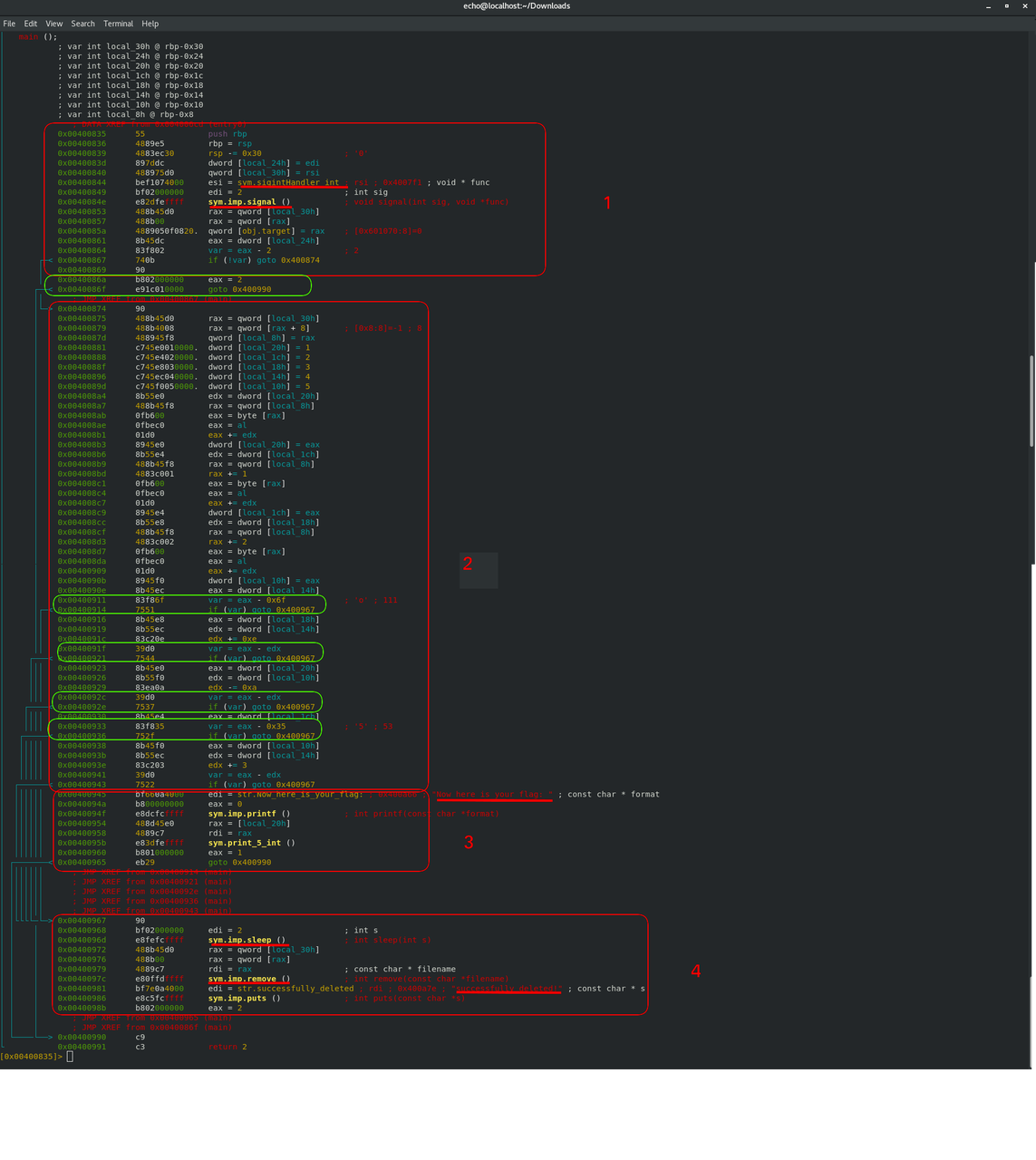
The key here is not to try to understand each individual line of code, you won't succeed. Just try to understand how the code flows, what instructions are executed after which one, what path does the code take... After a bit of thinking, I highlighted every goto instructions (which are in fact jump instructions that radare2 modified for us to make it more clear. That's what the ams.pseudo is doing, among other things). You could also use the VV command to see a graph representation of the program flow, that may be more visual.
- The beginning does some stuff, then, at the address
0x00400867, checks if a value equals 2. In some cases (I'm not sure which one it is), it jumps to the end of the program and nothing happens. Well, that exactly the behavior we encountered at the beginning, when we ran the program without an argument. So this beginning just sets up some stuff, then checks if an argument has been passed. If not, then it jumps to the end and the program just stops. - Then, we get some pretty complex logic, and a series of jumps that all lead to the same place, namely
0x00400967. - If we did not jump, we end up at
0x00400945, which calls a "printf()" with a very enticing "Now here is your flag:" string. That means we passed all the checks, and if we end up there, we are golden. But if we fail any of the checks, we end up at0x00400967. - At this address, we have a call to the very ominous
sym.imp.remove()function, as well as a call to theputs()function, with this string : "successfully deleted!". That's what happens when we give a random argument to the program! it deletes itself, then writes "successfully deleted!".
I now have a basic understanding of how this program behaves. I could try to read line by line the logic from 0x00400874 to 0x00400943, and understand what the program wants as an input. But I'm really bad at asm and this looks like hard work. I have an other (very bad) idea.
Bruteforce baby!
Do you remember why we could not try to pass random combinations of characters until we find the good one? The program would delete itself. what if I removed this instruction at 0x0040097c that keeps deleting our binary file if we don't pass the checks, and just simply try (a lot of) random letters? Well that's exactly what I did, for the better and (especially) for the worse.
radare2 allows us to modify a few lines of asm and reassemble our code. Here are the commands :
-
r2 -w executable-> open the binary with writing rights -
s 0x0040097c-> seek to the annoying call address -
wao nop-> replace the instruction here by anopinstruction, which does nothing.
Let's do the same for the sleep() instruction at 0x0040096d. If the program doesn't wait a few seconds before it closes every time, our bruteforce attack will be much faster. We can use the command pdf again to see how we changed the code :
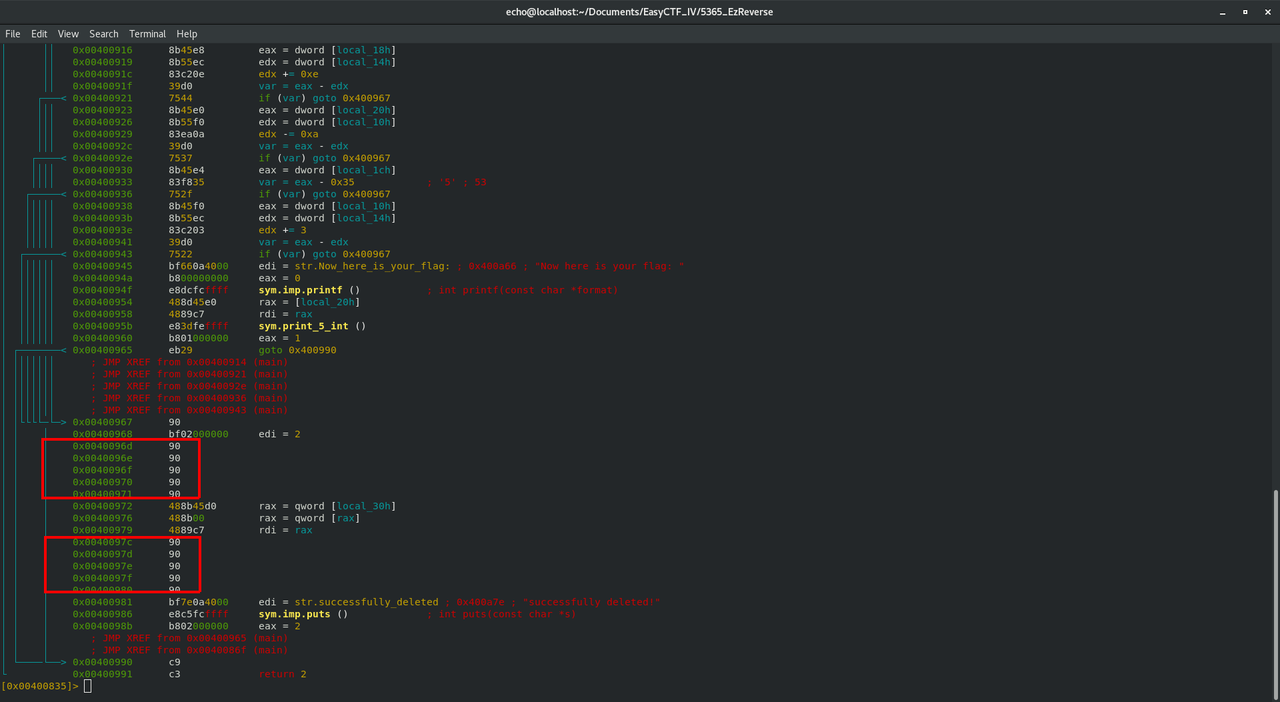
Let's press q a few time to quit radare2 and try our new executable (which I renamed to "PATCHED_executable")
$ ./PATCHED_executable "AAAABBBBCCCCDDDD" successfully deleted! [echo@localhost 5365_EzReverse]$ ls executable PATCHED_executable
And sure enough, it does says that it deletes stuff (since we didn't erase the call to puts() at 0x00400986), but a quick ls shows us that this is just a lie. Now we just have to write a quick script that tries to pass every possible combinations of characters to the executable. That must be easy, right? RIGHT?
Here is my annotated python script. It shouldn't be too hard to follow. Many thanks to CoryKramer on Stack Overflow for is answer on which my script is based. Also, thanks to the tqdm contributors, who saved me hours of wasted time staring at a screen (see below).
import subprocess import string from itertools import product from sys import exit from tqdm import tqdm # fancy progressbar guess = "" # string that will contain our argument chars = string.ascii_letters + string.digits # list of allowed characters guessLength = 0 # length of the argument at the start. Increase to start with a bigger password. print("\n\nBruteforce attack") print("-----------------\n") while True: guessLength = guessLength + 1 # let's search with one more character (starting with a 1 character long argument) expectedGuesses = len(chars) ** guessLength # the amount of guesses needed to try every combinations of characters print("Trying every arguments with length ", guessLength) with tqdm(total = expectedGuesses, mininterval = 1) as pbar: # fancy progressbar for guess in product(chars, repeat=guessLength): # iterates over all possibles combinations for guessLength characters pbar.update(1) guess = ''.join(guess) # our new argument exec = subprocess.run(["./PATCHED_executable", guess], stdout=subprocess.PIPE) # try to run the executable with our argument output = exec.stdout.decode('utf-8') if not 'deleted!' in output: # Analyse the output of the executable. If it doesn't say "successfully deleted!", we succeeded. print("ARGUMENT FOUND\n", guess, "\tOutput = ", output) exit() # else: # that would print the current guess. Commented for performance reasons. # print(guess, "\tOutput = ", output[:-1])
Let's run it !
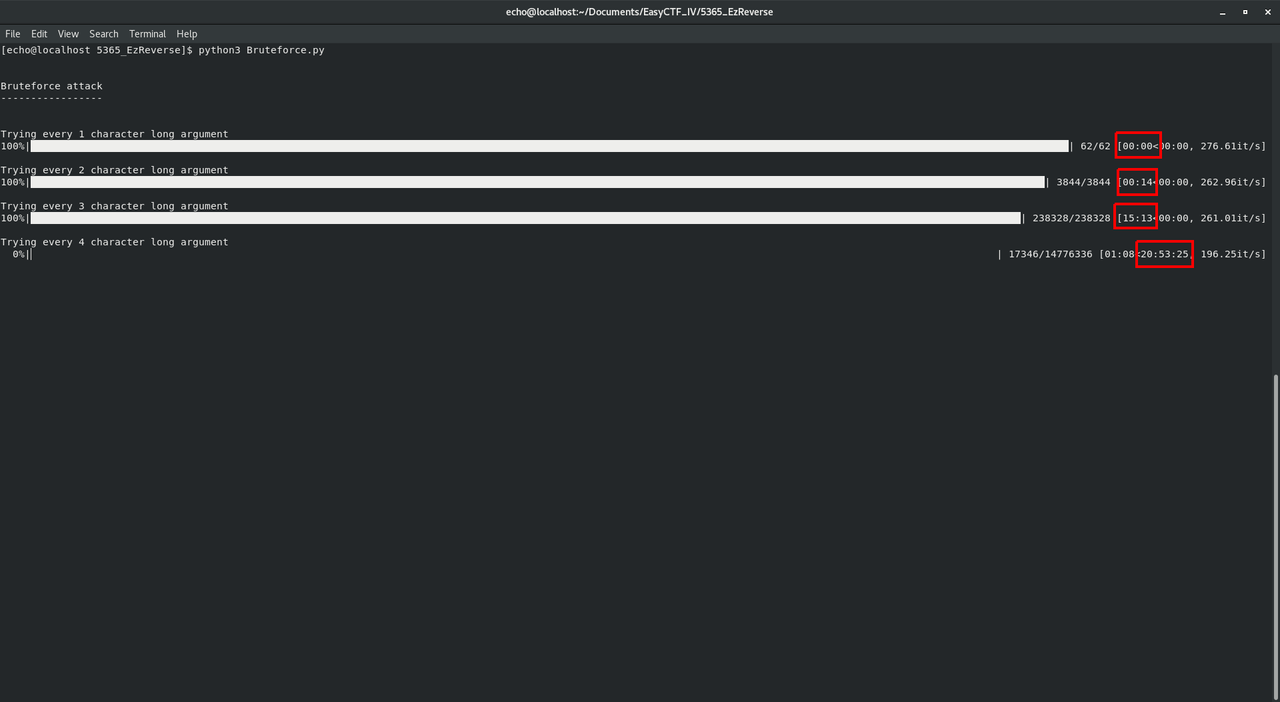
Uh oh... I initially didn't have the progress bar telling me the remaining time. So I thought everything would be ok. After waiting for quite a while I found tqdm, which was super easy to implement in my code, and gave me an expected remaining time. Turns out it's way too long. Remember that at this point I have no idea how long the expected argument is. Let's say it is 8 characters long. Well, that would give me around 236,000,000 hours to wait to try every combinations. So roughly 27,000 years.
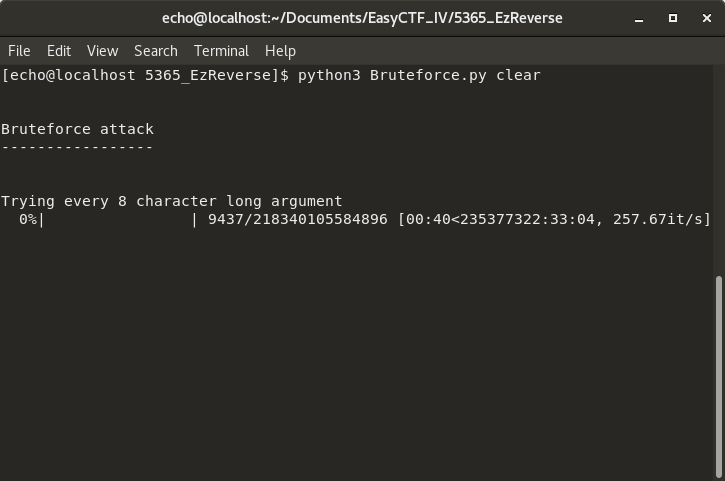
This kind of attack may be possible if I ran a compiled program, multithreaded to use a very fast multi-core processor. But my crappy single threaded Python code running on a small virtual machine won't cut it.
At this point, I'll need more information on the expected argument, to narrow down my bruteforce attack, or simply just find it first time, by understanding the disassembled code.
Let's try the smart way
After some hours spent staring at the asm code, I still have no idea what it does. Running it step by tep with radare2 didn't even help. So I decided to look into decompilers. Instead of simply disassembling the binary, decompilers try to recover the original source code. For interpreted languages, like Java, it's almost easy. But it is nearly impossible for compiled languages, like C or C++, because the compiler (GCC in our case), messes the original code too much when they generate the binary. Still, some programs claim to be able to do it.
I know that IDA Pro offers a state of the art C decompiler, but there is no way I can afford the (probably justified) 2629$ price tag (note : it looks like there might be a free personal licence available now in 2025). After a few failed attempts with snowman and REC Studio which only gave me some gibberish (which is probably my fault, to be fair), I ended up downloading Hopper Disassembler v4, with a free trial, and I can't recommend it enough. The free trial should be enough for you if you want to follow along with me.
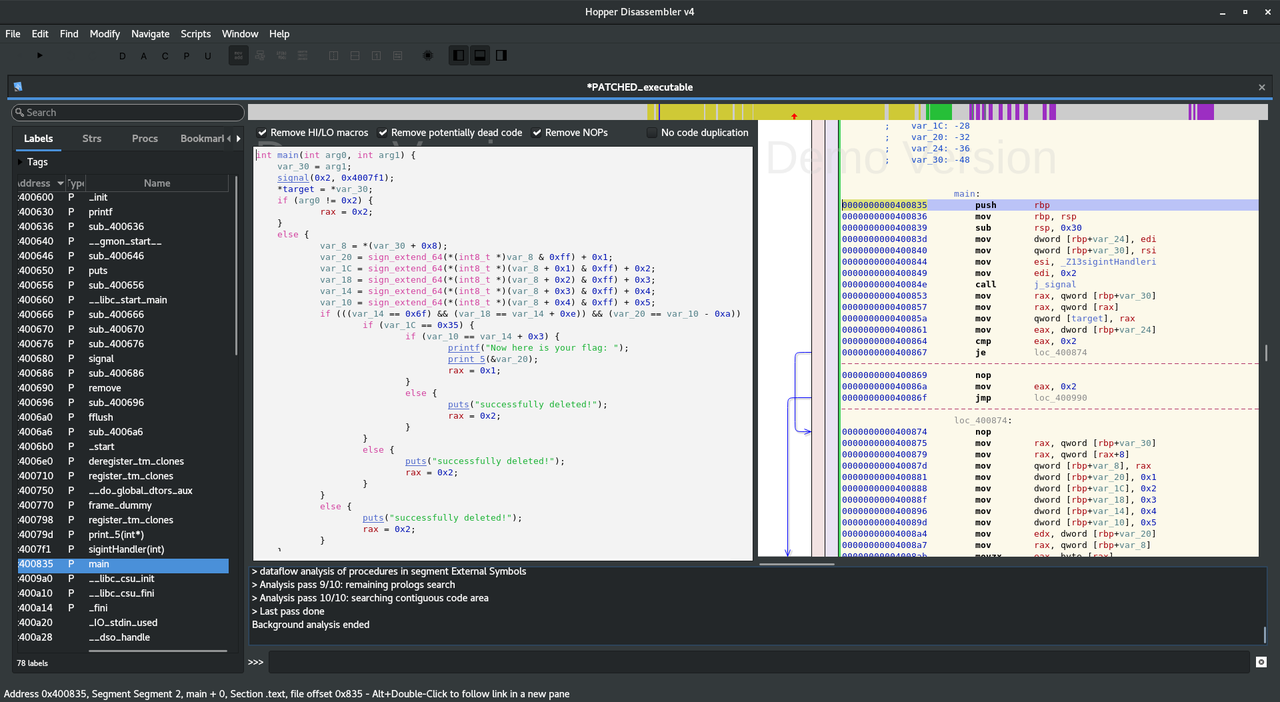
So I start Hopper, CTRL+SHIFT+O to open the binary, and the asm shows up. I can seek to main on the left panel, and then press ALT+ENTER to get the decompiled C code. I'll copy it to my text editor, as well as the two functions above main, which I just now understand that they are part of the C source and not some random gibberish added by GCC, and focus. We ended up with this :
int _Z7print_5Pi(int * arg0) { rax = printf("%d%d%d%d%d\n", *(int32_t *)arg0, *(int32_t *)(arg0 + 0x4), *(int32_t *)(arg0 + 0x8), *(int32_t *)(arg0 + 0xc), *(int32_t *)(arg0 + 0x10)); return rax; } int _Z13sigintHandleri(int arg0) { signal(0x2, 0x4007f1); puts("\n You thought you could avoid it huh?"); fflush(*stdout@@GLIBC_2.2.5); rax = *target; rax = remove(rax); return rax; } int main(int arg0, int arg1) { ; Variables: ; var_8: -8 ; var_10: -16 ; var_14: -20 ; var_18: -24 ; var_1C: -28 ; var_20: -32 ; var_24: -36 ; var_30: -48 var_30 = arg1; signal(0x2, 0x4007f1); *target = *var_30; if (arg0 != 0x2) { rax = 0x2; } else { var_8 = *(var_30 + 0x8); var_20 = sign_extend_64(*(int8_t *)var_8 & 0xff) + 0x1; var_1C = sign_extend_64(*(int8_t *)(var_8 + 0x1) & 0xff) + 0x2; var_18 = sign_extend_64(*(int8_t *)(var_8 + 0x2) & 0xff) + 0x3; var_14 = sign_extend_64(*(int8_t *)(var_8 + 0x3) & 0xff) + 0x4; var_10 = sign_extend_64(*(int8_t *)(var_8 + 0x4) & 0xff) + 0x5; if (((var_14 == 0x6f) && (var_18 == var_14 + 0xe)) && (var_20 == var_10 - 0xa)) { if (var_1C == 0x35) { if (var_10 == var_14 + 0x3) { printf("Now here is your flag: "); print_5(&var_20); rax = 0x1; } else { puts("successfully deleted!"); rax = 0x2; } } else { puts("successfully deleted!"); rax = 0x2; } } else { puts("successfully deleted!"); rax = 0x2; } } return rax; }
It's important to understand that this is no clean C code. GCC would throws thousands of errors trying to parse that. But it's still way more understandable to me than the asm code, and that was the goal. I'm not going to try to make it compilable, instead I'll try to understand how it works.
Also, at this point, it my be worth looking into the other write-up for this challenge I mentioned in the beginning. As it happens, the author, KosBeg, owns a IDA license. You can see how he didn't have too much work to do to cleanup his decompiled C code. Well, mine is not as nice, but still workable, and I didn't watch his stuff yet because I really wanted to do it myself. So lets start the cleanup !
int PrintFlag(int* flagAddress) { return printf("%d%d%d%d%d\n", *flagAddress, *(flagAddress + 0x4), *(flagAddress + 0x8), *(flagAddress + 0xc), *(flagAddress + 0x10)); // here we can see the order of the characters. // The PrintFlag() function is called with the address (Stack Pointer - 32) line 51. So (Stack Pointer - 32) must be the first character // Then, it looks 4 bytes ahead for the second character, so (Stack Pointer - 32 + 4 = Stack Pointer - 28) must be the second character // And so on... } // This function is responsible for the behavior of the program when pressing CTRL+C int SIGINTHandler(int argc) { signal(0x2, 0x4007f1); puts("\n You thought you could avoid it huh?"); fflush(*stdout@@GLIBC_2.2.5); /* rax = *target; remove(rax); */ // Once again, this target memory is a mystery for me. return rax; } int main(int argc, char** argv) { // Variables declared in memory. I did choose sensible names, thanks to the PrintFlag function() userInput: // Address = Stack Pointer -8 char5: // Address = Stack Pointer -16 char4: // Address = Stack Pointer -20 char3: // Address = Stack Pointer -24 char2: // Address = Stack Pointer -28 char1: // Address = Stack Pointer -32 var_24: // Address = Stack Pointer -36 inputAddress:// Address = Stack Pointer -48 int returnValue; inputAddress = argv; signal(2, *SIGINTHandler()); // signal needs a pointer to the function that is supposed to handle the signal, in our case SIGINTHandler() // *target = *inputAddress; // No freakin idea what this target memory is for, so just comment out. if (argc != 2) { // No argument? then return 2 returnValue = 2; } else { userInput = *(inputAddress + 0x8); // the user's input is at argv[1] char1 = userInput & 0xff) + 1; // we only keep the last 8 bits of the first letter, and add 1 to it. char2 = (userInput + 0x1) & 0xff) + 2; // same with every other letters char3 = (userInput + 0x2) & 0xff) + 3; char4 = (userInput + 0x3) & 0xff) + 4; char5 = (userInput + 0x4) & 0xff) + 5; if (((char4 == 0x6f) && (char3 == char4 + 0xe)) && (char1 == char5 - 0xa)) { if (char2 == 0x35) { if (char5 == char4 + 0x3) { printf("Now here is your flag: "); PrintFlag(&char1); // We send the address of char1, and it PrintFlag() will find the other characters from there. returnValue = 1; } else { sleep(0x2); remove(*inputAddress); // And that apparently is the line that deletes the binary file... somehow. puts("successfully deleted!"); returnValue = 2; } } else { sleep(0x2); remove(*inputAddress); puts("successfully deleted!"); returnValue = 2; } } else { sleep(0x2); remove(*inputAddress); puts("successfully deleted!"); returnValue = 2; } } return returnValue; }
Now that's more readable isn't it ? The most interesting part happens just after the else statement. The program filters the argument, the adds 1 to the first character, 2 to the second, 3 to the third, 4 to the fourth, and 5 to the fifth. Then, it verifies some conditions, and if those are satisfied, it print the flag.
One thing to remember is that the characters in the conditions have been altered above. So char4 == 0x6f in fact checks if the fourth character we passed plus four equals 0x6f. Following this principle, we can write a list of constraints our argument must follow. And here is what I ended up with :
(char1 + 1) == (char5 + 5) - 0xa (char2 + 2) == 0x35 (char3 + 3) == (char4 + 4) + 0xe (char4 + 4) == 0x6f (char5 + 5) == (char4 + 4) + 0x3
Now it's just some elementary school arithmetic problem. Just remember what is hexadecimal and what is decimal. Let's solve this step by step.
char1 == char5 - 4 char1 == 0x6a char2 == 0x33 char2 == 0x33 char3 == char4 + 16 <=> char3 == 0x7a char4 == 0x6f - 4 char4 == 0x6b char5 = char4 - 2 char5 == 0x6d
Now we just have to use our trusty ASCII table to convert those hexadecimal numbers to characters. And we get the string "g3zkm". Let's try it!
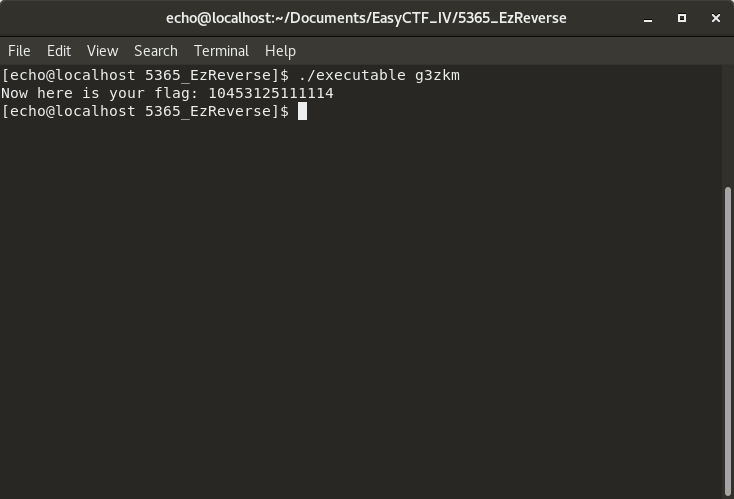
And sure enough, we did it !
Bonus : solving with z3
I heard about how amazing z3 is, and at this point, I did read KosBeg's write-up, in which he did use z3 to solve the equation system. So I wanted to try it myself, without just copying his script. Turns out, our scripts are pretty similar, but I'll post mine here anyway :
import z3 import string flag = "" char1 = z3.Int("char1") # defines int variables in z3 char2 = z3.Int("char2") char3 = z3.Int("char3") char4 = z3.Int("char4") char5 = z3.Int("char5") s = z3.Solver() s.add(char1 + 1 == char5 + 5 - 0xa) # define the equations in z3 s.add(char2 + 2 == 0x35) s.add(char3 + 3 == char4 + 4 + 0xe) s.add(char4 + 4 == 0x6f) s.add(char5 + 5 == char4 + 4 + 0x3) while s.check() != z3.sat: # we wait for z3 to do its thing if s.check == z3.unsat: print("No solution found") else: for k, v in s.statistics(): print("%s : %s" % (k, v)) flag += chr(s.model()[char1].as_long()) # now we annoyingly have to convert the ints of z3 to characters flag += chr(s.model()[char2].as_long()) # this took me way too long to find... flag += chr(s.model()[char3].as_long()) flag += chr(s.model()[char4].as_long()) flag += chr(s.model()[char5].as_long()) print(flag) # nice !
And sure enough, that works too
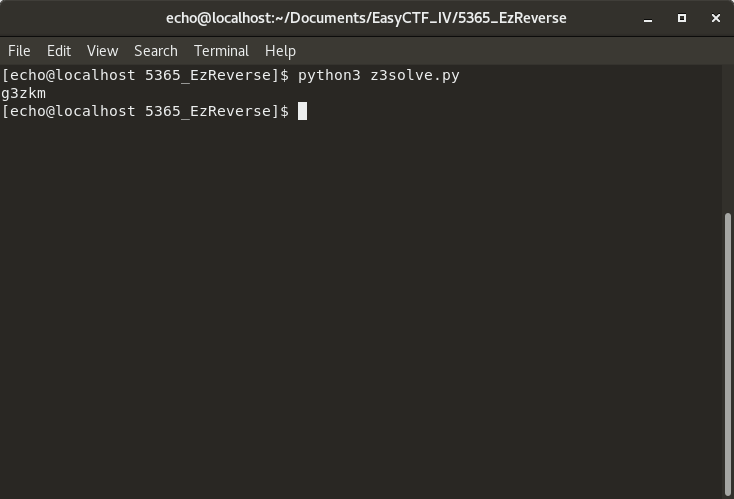
Conclusion
Seven years have passed, yet this reverse engineering challenge stayed in my mind like it was yesterday. Not because I became an assembly wizard (I definitely did not!), but it gave me something very valuable: technical intuition. Understanding (at an admittedly high level) how compilers generate code, how CPUs read data from registers, how to interpret stack traces... all of those became part my general base of knowledge, helping me solve seemingly unrelated problems.
To my surprise, parts of this "useless" knowledge sometimes come back even more directly. I still use hexdump and z3 from time to time, and the itertools.product() function in that failed brute-force script saved me from some really ugly nested loops just yesterday.
So to you, dear reader who wandered through this old memory with me: never dismiss knowledge as irrelevant. What seems like a detour today may become tomorrow’s shortcut. And remember to chmod +x your executables!